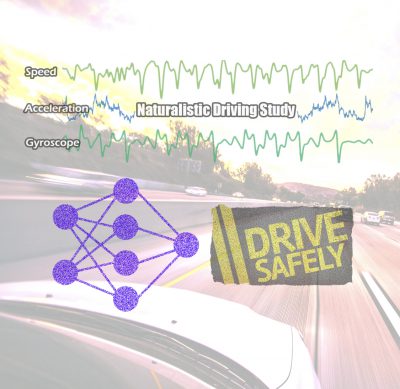
Abstract
The emerging connected vehicle and Automated Driving System (ADS) as well as widely available advanced in-vehicle telematics data collection/transmitting systems produce gigantic amount of high-frequency, high-resolution driving data. These telematics data provide comprehensive information on driving style, driving environment, road condition, and vehicle condition. The telematics data has been used for a number of safety areas such as insurance pricing, teenage driving risk evaluation, and fleet safety management. The surge of ride-hailing service in the last decade provides a novel alternative mode for travelers. The ride-hailing drivers are a unique driver population with substantial operational responsibilities and the safety management is critical for the drivers. The smartphone ride-hailing app can conveniently collect kinematic information from sensors on smartphones, thus make the telematics data available for the entire driver population. Parallel to this proposed study, the research team has evaluated telematics feature in prediction crash risk for millions of ride-hailing drivers. This project will address the following main safety research questions using high-frequency, high resolution telematics data: 1) characterize the high-frequency kinematic signatures for safety critical events as well as during normal operations; 2) develop models to predict high risk drivers based on the kinematics signatures. 3) develop models to distinguish and predict crashes from normal driving scenarios based on the high frequency data. The project will contribute to connected vehicles and ADS real-time safety monitoring, NDS data analysis, hail-driving driver safety prediction, as well as fleet and driver safety management programs.
Project Highlights
- The project developed two deep-learning models to evaluate driving risk using high-frequency, high-resolution kinematic driving data.
- A combination of multiple deep learning methods, including CNN, GRU, and XGBoost, are used to capture the key features of safety critical events and predict rare crash events.
- We applied the proposed deep learning risk prediction model to the SHRP 2 NDS. The results showed a clear separation of crashes and normal driving segments in the latent representation space.
- We propose a Variational Inference of Extremal (VIE) approach for rare event prediction. The VIE model induces uncertainty to representation learning through a generalized Pareto distribution, which can accommodate rare events through its long distribution tails.
- The VIE rare event model was also applied to the SHRP 2 NDS data. The proposed model universally outperforms several state-of-the-art benchmark models.
- The two novel modeling frameworks proposed in this study allow prediction of instantaneous crash risk based on high-frequency kinematic driving data, which are widely available through smartphones, CV technology, and ADS.
Final Report
EWD & T2 Products
The project contents have been used in multiple courses:
- Stat Epi. & Obs. Studies (STAT 5374), Spring 2020
- Applied Multivariate Analysis (STAT5504G/STAT4504), Spring 2021
The project was presented in a webinar, “Driving Risk Assessment Based on High-frequency, High-resolution Telematics Data,” on August 26, 2021.
WEB APP – This webapp detects/predicts crashes and near-crashes based on kinematic driving data. The model adopts a combination of convolutional neural network (CNN) and gated recurrent unit (GRU) network to capture both local features and temporal dependency of the kinematic signatures.
Student Impact Statement – Liang Shi and Chen Qian (pdf): The student(s) working on this project provided an impact statement describing what the project allowed them to learn/do/practice and how it benefited their education.
Presentations/Publications
“C’est La VIE: Variational Inference of Extremal for Rare Event Modeling,” submitted to Annals of Applied Statistics
“Real-Time Traffic Safety Critical Events Prediction using Deep Learning Models”; draft manuscript completed
“Driving Risk Assessment Based on High-frequency, High-resolution Telematics Data”, SafeD UTC Final Report
Webtool: https://utc-deep-prediction.cloud.vtti.vt.edu/
JSM 2021, Zoom, 08-10-2021, A Hybrid Approach for Traffic Crash Identification Using Deep Learning and Xgboost, Liang Shi
Chen Qian. Variational Inference for Rare event Modeling and its application in transportation safety, 2021 American Statistician Association Transportation Statistics Interest Group Annual meeting, August 27, 2021
Chen Qian. C’est La VIE: Variational Inference of Extremal for Rare Event Modeling, 2021 Joint Statistics Meeting, August 10, 2021
Joint Statistical Meeting 2021, 08-10-2021, A Hybrid Approach for Traffic Crash Identification Using Deep Learning and Xgboost, presenter: Liang Shi
Joint Statistical Meeting 2021, 08-10-2021, C’est La VIE: Variational Inference of Extremal for Rare Event Modeling, presenter: Chen Qian.
American Statistician Association Transportation Statistics Interest Group Annual Meeting, August 27, 2021
Variational Inference for Rare event Modeling and its application in transportation safety, presenter: Chen Qian.
Final Dataset
The SHRP 2 dataset was used to evaluate the performance of the proposed time-series data classification approach. This database contains more than 1,000,000 hours of continuous naturalistic driving data driven by 3,221 drivers under daily normal driving conditions without specific instructions. A sophisticated data acquisition system was installed in each participant’s own vehicle, which continuously collected key driving data, including four camera views, GPS, three-dimensional acceleration, yaw rates, etc. The research team extracted tens of thousands of normal driving conditions with matching initial and ending speeds as crashes and near-crashes. These data will be saved in data repositories for future use.
Research Investigators (PI*)
Feng Guo (VTTI/VT)*
Chen Qian (Student-VTTI/VT)
Liang Shi (Student-VTTI/VT)
Project Information
Start Date: 2019-12-15
End Date: 2021-08-30
Status: Closed
Grant Number: 69A3551747115
Total Funding: $150,000.00
Source Organization: Safe-D National UTC
Project Number: VTTI-00-028
Safe-D Theme Areas
Big Data Analytics
Automated Vehicles
Connected Vehicles
Safe-D Application Areas
Risk Assessment
Driver Factors and Influences
Performance Measures
Planning for Safety
More Information
Sponsor Organization
Office of the Assistant Secretary for Research and Technology
University Transportation Centers Program
Department of Transportation
Washington, DC 20590 United States
Performing Organization
Virginia Polytechnic Institute and State University
Virginia Tech Transportation Institute
3500 Transportation Research Plaza
Blacksburg, Virginia 24061
USA
